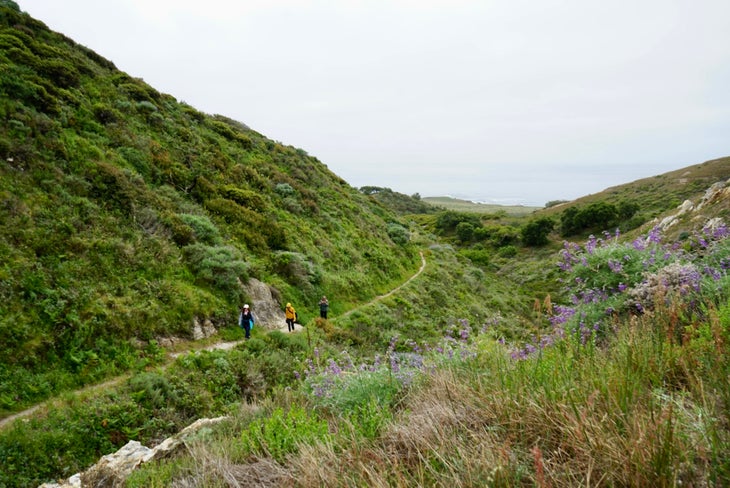Heading out the door? Read this article on the new Outside+ app available now on iOS devices for members! Download the app.
When I told a friend that I’d never even heard of the San Luis Obispo Valley on California’s central coast, she gasped in mock horror at my ignorance. Thus burned, I had to take a trip to California’s famous wine country to redeem myself. That’s what friendship is for anyway, right? When my plane landed at the quaint, local airport in SLO, I had just two objectives in mind: I wanted to surf, and I wanted to hike. And I wouldn’t be mad about a glass of cold-climate pinot grigio.
A quick drive to the sleepy town of Cayucos quickly fulfilled the first objective. The break was beginner-friendly and consistent even in the early spring months. The nearby bluffs were riddled with hiking trails to discover between sets of waves. On these bluffs, I could cast my eyes on curious harbor seals who bobbed their heads in my direction. I thought I had seen the best of the area’s trails, but then, a friendly local told me that Montaña de Oro State Park was his favorite place in the state. I knew I had to see it for myself.

Montaña de Oro State Park
Named after California’s famous golden poppies, Montaña de Oro (translates to “Mountain of Gold”) is an 8,000-acre hiking haven with an array of mountain trails, coastal bluffs, tide pools, and even endemic species. It officially became a state park in 1965 when the state of California purchased the parcel from a private owner, but its history dates back thousands of years.
Before the first Europeans arrived in California, the Chumash and Salinan people called Montaña de Oro their home. In fact, the region sustained these tribes for more than 9,000 years. In the 18th century, settlers arrived, quickly establishing a Spanish presence in the area. Eventually, the territory became part of two Mexican land grants. Today, the state park sees about half a million annual visitors who come to the park to picnic, horseback ride, camp, mountain bike, and hike. It’s a lot quieter than its national park counterparts: Sequoia NP receives about 1 million visitors in a year, and Yosemite NP hosts more than 4 million.
Rattlesnake Flats Trail
A 20-minute drive from Cayucos took me and some friends to the Montaña de Oro park entrance just south of Los Osos. Wildheart Coastal Adventures’s Mandy Davis joined us on this trip as a naturalist and guide, giving us a few different choices for our morning hike. Ultimately, we landed on the Rattlesnake Flats Trail, knowing that there was an option to extend the trek if we were feeling adventurous.
Rattlesnake Flats took us from a parking area that overlooked the Pacific down the Coon Trail through a shadowy grove of trees. It was there where we learned that Montaña de Oro is home to an elfin forest, an old oak grove with gangly, ancient branches that look like they could cast a spell or two. The state park as a whole protects about 90 acres of these trees–many of which are over 800 years old.
After exiting the spooky grove, the trail meanders through long grass, past meadows of flowers deep into the mountains before eventually looping back toward the beach. The trail was well-maintained and predominantly made of fine gravel and patches of sand.
Although I didn’t get the chance to visit Montaña de Oro’s shoreline, I did wander through the seaside bluffs just north of the park the next day. A bonus trek up there brought me to tide pools with anemones, snails, and crabs. It was the cherry on top of an already mesmerizing adventure.
I’ve hiked all around the world, collecting trail miles like souvenirs. I’ve thru-hiked the Appalachian Trail and Colorado Trail. Throughout my treks, I’ve found that in many places, the surrounding peaks and valleys can sometimes start to blur together and look monotonous after a couple miles. But Rattlesnake Flats Trail in Montaña de Oro reminded me that a place can be varied, unique, and ever-changing even within a single hike.

Additional Trails in the Park
I was only in the park for the day, but here are some additional trails locals recommend for their regionally specific beauty—and all of which are on my ticklist for a return trip.
Valencia Peak Trail
As a 4.5-mile trek with 1,275-feet of elevation gain, Valencia Peak is slightly more challenging than Rattlesnake Flats, but the effort is worth it. The peak itself provides 360-degree views of the surrounding coast and mountains, and it’s one of the tallest destinations in the state park. The start of the hike is located at the parking area near Holloway Garden on Pecho Valley Road. This is a great challenge for those who want to summit a peak in the area.
Bluff Trail
An ocean-oriented hike, the Bluff Trail follows the state park’s coast, giving hikers access to tide pools at low tide. The trail begins at the Pecho Valley Road parking area near the Holloway Garden and meanders along the coast before cutting inland toward the road, then turning back and retracing steps to the start. Don’t want an out-and-back? Hikers could turn the trek into a loop by following Pecho Valley Road back to the trailhead, too.
Endemic Species in Montaña de Oro State Park
Montaña de Oro is full of endemic species including creatures like the threatened Morro shoulderband snail. Also, splitting yarn lichen is a plant that resembles Spanish moss, but it’s only in Los Osos and the Baywood area of California. The region is also home to butterflies, sea creatures, and a host of additional plants that aren’t anywhere else in the world.
From 2025
